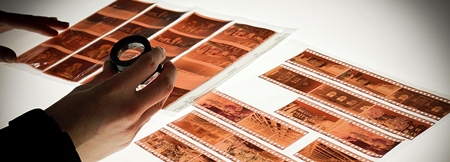As technology takes over our lives, we older photographers tend to remember with much fondness the pre-digital age photography.
One of the most important factors was to see if the shot had a sharp image. With a portrait, focusing on the eyes was the standard way, but until you got the negatives back and could check with the enlarger, there were many hours of anxiety. Had you really got the image that was required, because with professional photography, if you goofed, you re-shot at your own expense. And if that shoot included professional model fees, you were going to be considerably out of pocket.
Those were the days when film was king, and B&W revered for the creativity it could encourage. In the darkroom, with the magical red light, you became accustomed to the gloom and would spend time working out the correct exposure for the exposed photographic paper. This was done by successive exposures, sliding a cover paper back by two seconds at a time. You then dipped and dunked and reviewed the exposed and developed sheet and chose the best time under the enlarger head giving the best exposure.

However, it wasn’t over then. Next you exposed one sheet for the suggested time, dipped and dunked and reviewed again. This time you looked critically at the whole print (usually a 10×8) and noted areas that needed ‘burning in’ and other areas that needed ‘holding back’ (or ‘dodging’) and the process would go on again until the final, definitive print was made. This process could take several hours, but your B&W creation was part of your artistic persona.
I was lucky in that I was using a newspaper’s darkroom for my B&W work in those days, and this had an auto-processor which would take your exposed sheets and finish printing them in one minute. Sixty seconds of anxiety was not so bad, compared to dipping, dunking and fixing, which could take 15 minutes.
That was for B&W, but the situation for color negatives was somewhat different – and, incidentally, the photographic technique was also somewhat different. Where you looked at light and shadow in B&W, with color you began to look at contrasting colors and hues. Blues pitched against yellows, reds against whites.
It was also the situation that very few people had access to a color printer, and this was the province of the professional shooter. You dropped off your exposed roll of color film and you received back the analyzer report as to the exposure saturation of the negatives, as well as a roll proof taken from the negatives. This was the way you checked your expertise with the flash meter and the exposure meter. The alterations to a print were done in the camera beforehand, not afterwards as with the B&W photography. As you became more experienced you could guesstimate the settings needed to visually change the end result. It was a complete new ball game.
After this period came the scanned print directly into the computer, where color balance, brightness and contrast could be manipulated, followed by the ability to take the color negative and scan that into the computer, cutting out the negative to print step, which came with its resultant lowering of sharpness.
But now we have the fully digital phase of photography, available to everyone, not just the professionals. Your digital SLR even gives you a choice of resolution and file types such as RAW or JPEG. And on top of all this, there is that magical ability to review your photographs while they are still just electronic images on your memory card.
However, you should not just take the image for granted. You should still critically review your images and work out what should be done or changed. Just because you have a DSLR does not mean that you will never get a bad picture. The photographer has the “eye”, not the camera!
To really hammer this concept home, I was chatting to a pro photographer at the weekend and he can take 3,000 images on a shoot and was saying how long it takes him to review all the shots, to make sure he has the best ones!




